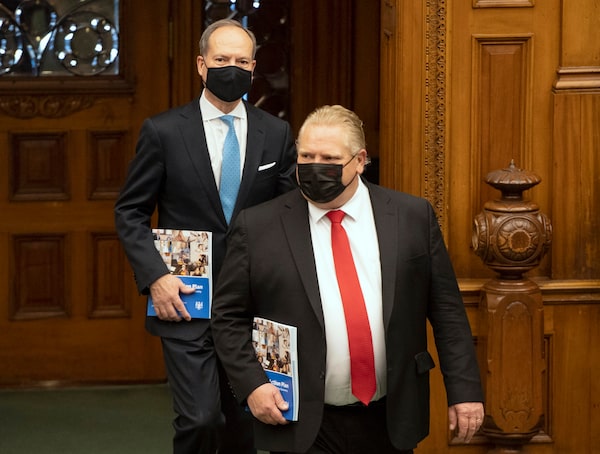
Ontario Finance Minister Peter Bethlenfalvy, left, and Premier Doug Ford arrive in the Ontario Legislature in Toronto on March 24. Bethlenfalvy says the province's economic recovery 'is built on growth, not tax increases or spending cuts.'Frank Gunn/The Canadian Press
Ontario is flattening its debt curve as surging tax revenues from a quickening economic rebound slash the province’s pandemic-swollen deficit.
Instead of a sharp rise in the ratio of net debt to GDP, the province’s Progressive Conservative government now forecasts, in the economic and fiscal update released on Thursday, a flat-lining over the next three years, well below its self-imposed ceiling.
Under the most optimistic scenario, debt as a proportion of the economy would snap back to prepandemic levels by fiscal 2023-24.
But those forecasts don’t take into account the costs of any promises that will emerge in the provincial election campaign slated for next year. And they depend in part on the government following through on its intention to cut spending on education in real terms in the current fiscal year.
Driving that turnaround is a blistering pace of nominal growth in the province’s gross domestic product, forecast to rise by 9 per cent this year, up from the 6.6-per-cent estimate in the March budget. That’s the highest growth in nominal GDP since 1988.
As a result, the Ontario Finance Ministry is projecting a sharp increase in revenues from personal income taxes, corporate income taxes and sales taxes. That broad-based jump in tax revenues points to a possible upside for the federal government as well, with the Liberals yet to deliver their own fall economic statement.
Ottawa’s pandemic spending spurs tax-revenue windfall in Ontario
In September, Ontario unveiled a similar windfall for the previous fiscal year, saying that Ottawa’s massive pandemic spending had increased revenue from personal and corporate income taxes, even though the provincial economy contracted.
For the current fiscal year, Ontario’s biggest gain has come from personal income taxes, now projected to be $41.3-billion, up $4.9-billion from the budget forecast of $36.4-billion. Sales tax revenues are now forecast to be $31-billion, up from the expected $27.6-billion in March. The biggest percentage jump has come in corporate tax revenues, up 18 per cent from the $14.4-billion forecast in the spring budget, and now projected to be $17-billion.
Those and other gains will deliver a revenue windfall of $14.6-billion in the current fiscal year. For the most part, the province will use those funds to reduce its deficit, with spending $3-billion higher than projected in the spring budget.
“Our plan for recovery is built on growth, not tax increases or spending cuts,” Ontario Finance Minister Peter Bethlenfalvy told the legislature as he presented the economic and fiscal update.
There is a notable exception to Mr. Bethlenfalvy’s assertion of avoiding cuts: education. Nominal spending on education is slated to rise slightly, by just under 1 per cent, in the current fiscal year. But once inflation is taken into account, that amounts to a cut in real terms.
Ontario’s projected deficits through to 2024, while still substantial, are much smaller than those contemplated in the spring budget, as the chart below shows.
For the current fiscal year, the province now forecasts a $21.5-billion deficit, down from the earlier estimate of $33.1-billion. By the end of fiscal 2024, the deficit will have narrowed to $12.9-billion, Ontario’s Finance Ministry forecasts, far lower than the $20.2-billion estimate in the spring budget.
The combination of a sharp uptick in revenues, holding the line on spending and galloping economic growth will reverse what had been a projected rise in the province’s debt burden relative to the economy, as this second chart shows.
As recently as March, the government had forecast that debt would rise through to fiscal 2024, with the ratio of net debt to GDP reaching 50.2 per cent that year, brushing against a self-imposed limit of 50.5 per cent.
Ontario is now projecting that its debt ratio will essentially be flat through to 2024, declining slightly from 43.9 per cent at the end of fiscal 2021 to 43.6 per cent in 2024.
Moody’s Investors Service, the credit-ratings agency, said Ontario’s fiscal update of smaller deficits and reduced borrowing requirements is credit positive for the province.
Marc Desormeaux, senior economist at Scotiabank, said the results represent a “significant improvement” in Ontario’s fiscal situation. He noted that the GDP projections the province used are lower than private-sector forecasts, leaving open the possibility of further revenue gains. “There’s certainly some upside potential,” he said.
The province’s economic update gives some insight into that possibility. Under a higher-growth scenario, real GDP growth would hit 6 per cent in 2022 rather than the 4.5 per cent that the government used in preparing its baseline estimates. Growth in 2023 and 2024 would be 2.9 per cent and 2.3 per cent respectively compared to the baseline estimates of 2.6 per cent and 2 per cent.
Under that high-growth scenario, Ontario’s deficit and relative debt burden would shrink even more rapidly. By 2024, the deficit would be just $4.5-billion. And the province’s ratio of net debt to GDP would tumble sharply, declining to 40.4 per cent – and leaving Ontario in about the same position it was in before the pandemic struck.
Tax and Spend examines the intricacies and oddities of taxation and government spending.
Sign up for the Tax and Spend newsletter.